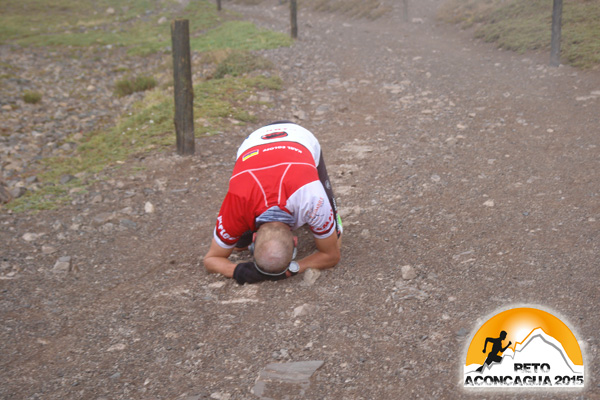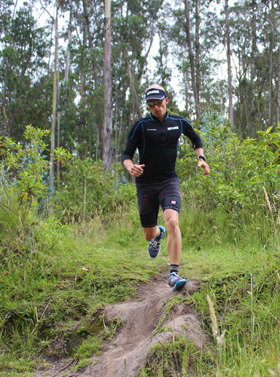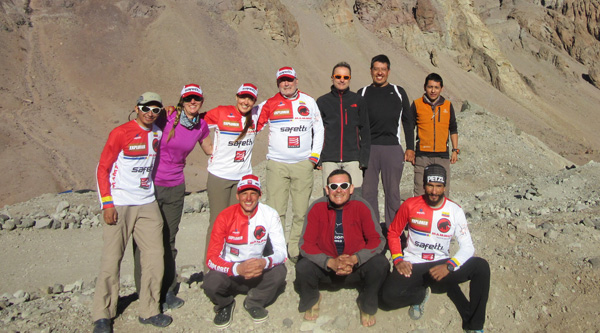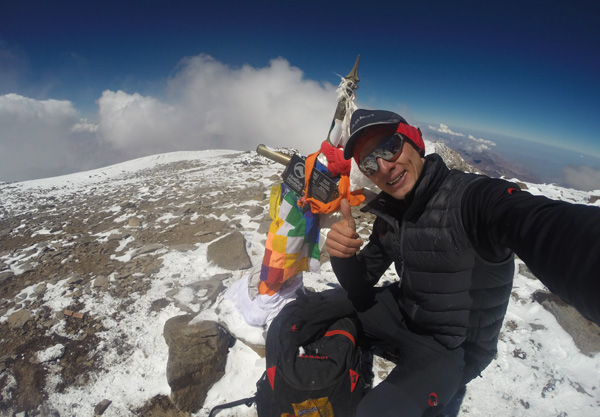
Today, I am very pleased to bring you an interview with Karl Egloff, the new Aconcagua speed climb record holder with a time of 11h 52min! He kindly agreed to do it for SkinTrack readers.
Mountaineering and trail running community knows Aconcagua (6,962 m or 22,837 ft) very well, however, many learnt about it only in December last year. Kilian Jornet, the famed Catalan runner and ski mountaineer, set a new speed record for ascent and descent on the mountain.
Jornet demolished the previous record by about one hour and set the new mark at 12 hours 49 minutes following the normal route, with a start and finish in Horcones that sits at altitude of 2850m and about 30km away from the summit. Pretty much all of us thought the record would stand for at least couple of years but fast-forward to Feb 19, 2014 – only two months later – and Karl Egloff broke Jornet’s record by a whopping 57 minutes!
Without further due, let’s learn as much as we can about a man that was flying low under the radar for very long time.
Karl Egloff interview
Q: Karl, first of all, big congratulations on your amazing performance! What did you feel in the last hour as you were running back to Horcones?
Thank you so much Stano and SkinTrack! I was feeling many emotions during the record. I knew all the time that I had one hour of advantage so I tried to stay focused and enjoy coming back to where I started.
For me the return from Plaza de Mulas down to Horcones, were the most difficult kilometers (23 km) because the weather changed and it started to snow with heavy wind and temperature dropped down. I was cold and my legs were tired.

My mother was Ecuadorian (unfortunately, she passed away when she was 49 and I was only 16), my father is Swiss.
In Ecuador football is not a sport, it is a religion. I stared at an early age to play football. When I was 17, I moved to Switzerland and my father wanted me to study before focusing in any sport career. I tried to play football in my spare time. When 26 I returned to Ecuador and finally tried to get professional in football but I was too old and I had a serious injury in my abductors, so my doctor asked my to use the bicycle for recovery. This is how I started in mountain biking and immediately fell in love with the sport.
A few months later, I started competing in local races. I was an elite mountain biker from 2008 through 2014, earned 70 gold medals for Ecuador, traveled worldwide to compete in mountain bike events.
In the meantime I never stopped working on my true passion, being a mountain guide. I guided local and international expeditions to Peru, Nepal and Tanzania. At the time my clients rested and in order to keep in shape, I went out for a run in the altitude. That is when I realized my strength in this activity. In 2014 I traveled to Kilimanjaro for the 4th time as part of a commercial trekking tour I was hired to lead, and I tried the Kilimanjaro speed record. After I achieved this incredible record I slowly switched from mountain biking to the world of trail running, speed climbing and strengthening my mountaineering.
Q: When did you realize you wanted to go up and down mountains really fast?
 On December 12, 2012 I was invited to climb Cotopaxi fast with a friend of mine. I broke the speed record and since then I started to see how amazing this sport could be after guiding almost 16 years.
On December 12, 2012 I was invited to climb Cotopaxi fast with a friend of mine. I broke the speed record and since then I started to see how amazing this sport could be after guiding almost 16 years.
Q: How old are you?
33
Q: What other sports do you actively do?
I do rock climbing from time to time.
Q: In running, compared to others, do you feel like you excel in going up or down? Which one do you like more?
Both, I love to climb definitely but technical descents are also very exciting for me.
Q: Do you do many races or you race only occasionally? I haven’t seen you in any results before, but of course, I do not follow all races.
I started with trail events last year. I participated in three races in 2014 and won all three. This year I have some more in planning and I hope to do one or two also in Europe.
Q: Our readers are very active and many are competitive mountain athletes, so they would like to know more about your training and preparation. How did you train for Aconcagua in the last 2-3 months, did you do lots of high intensity intervals or lots of volume?
Two months of biking training after Kilimanjaro record, then two months of altitude training with a lot of nights over 3500m, and some interval training over 5000m. Then three weeks before travelling to Argentina I focused on trail running events to train my heart to maintain rhythm.

I climbed Aconcagua and reached summit three times in eight days. I slept three nights in a row at 5500m, and did intensity training at over 6000m.
Before travelling I did a lot of acclimatization in Ecuador, the greatest country to do trail and mountaineering in the Andes. We have quite a lot of mountains and altitudes for training: 4000m, some 5000 and even a 6000m mountain.

No, there are none here in Ecuador. I went to the mountains and slept over 5000m with the best natural view to enjoy!
Q: Why did you choose end of February for your speed attempt?
Because it is cheaper to enter the national park, and because my clients had carnival holidays and could travel. Then because the weather is ok, colder and much more windy but not so many tourists. This trip was planned a year ago.

Dinner was pasta, breakfast just fresh fruits and carbs drink. During the record a lot of electrolytes, gums, sugar, chocolate and hot tea.
Q: Where did you have your support people positioned on the mountain? What did they provide and what did you carry?
At 7km at Confluencia, César Alvarado for support in low camp. At 23km (base camp) Nicolas Miranda, expert Ecuadorian mountain guide and adventure athlete was waiting for me – I changed shoes, ate something and he joined me to the summit. Ivan Herrera was waiting at the cave at 6700m before the last climb with hot tea, clothes and some food. The way down, from the summit to the gate I went all by myself.

I changed shoes on Plaza de Mulas on the way up and changed socks and shoes on the way back at Plaza de Mulas.
Q: Running 12h alone is a long time, what did you think about during all that time?
I was thinking 80% of the running time about the record time, making calculations. When I was feeling weak I started to think about the main reason why I was there for – my girlfriend, my family, my friends and all the people who were supporting me.
I raced in adventure races over 3 or 4 days. During those races, you sometimes don’t thing about anything, it’s like a blanco moment, but during the Aconcagua record I was very focused all the time.
Q: You beat Kilian’s record on Kilimanjaro in 2014 by about 30 minutes. Based on that, how much did you think you could go faster on Aconcagua?
Yes, by 32 min in 2014, my time was 6h 56min. For Kilimanjaro I trained good but didn’t feel that I was at my best shape. When I came back, and with the experience in Africa, I knew how to get well prepared and focused on Aconcagua. We knew we had a chance so we trained for it really hard.

I’m sponsored by a sports medicine company were I get all the massages and health check-ups, but as a guide during the high season (Nov-Dec-Jan) I’m more on the mountains than at home so I recover on the mountains at the base camps.
It is demanding so sometimes when I’m guiding and come back home the only thing I do is intensity training to keep fit and avoid injuries.
» Visit Karl’s guiding company website – Cumbre Tours – if you are planning trips to South America or around the world.
Q: What is your favourite testing mountain or a climb? Is it steep, technical, or not so much?
I live just 10 min away from a steep hill where I train every day. It is technical, it is steep and it is almost at 3000m – a great hill just in front of my door.
Q: Any other bigger mountains?
Cotopaxi volcano (5,897m) and its national park is probably the best scenery for me for training. It is just 1 hour away by car and you have amazing landscapes at 4000m altitude to trail above the giant glacier.
Q: At what altitude do you live most of the year?
2800m
Q: Who inspires you the most and why?
Roger Federer because he is a gentlemen and a great sportsman. Kilian Jornet because he is an incredible athlete and has broken the traditional rule of “not to run on the mountains”. Reinhold Messner because he made what impossible things possible.
And my mother, she was fighting years against cancer and prepared us during her sickness for life.
Q: Are you going after Kilian Jornet’s records or are you just going after the same summits but he happened to start his project sooner?
I’m going for the 7 summits because they are commercial, they have records, they are in books and people know all of them. The Himalayas is far away for me economically right now, but I hope one day we can have a chance to go for it. I also want to cross the Antarctica, which I dream about since I was a kid.

All emblematic and symbolic mountains in South America, Europe and Himalayas if I have the health, the team and the money.
Q: Would you consider attempting the Matterhorn record? Or do you think to go faster there requires too much risk taking?
I have never climbed Matterhorn. My sister got married in Zermatt but we did not have time to climb it. I hope I will get the chance and then I will talk about a record.
Q: Do you have any sponsors? What running shoes and clothing do you use?
I’m sponsored by Mammut gear in Ecuador so I use Mammut shoes. Compressport is also sponsoring me internationally. I have also several other sponsors in Ecuador.
Q: Do you follow any special diet – vegetarian, vegan, paleo…?
No, I’m a big meat lover. I eat whatever I want and have never had a diet. Life is too short for diets but I eat healthy.
Q: Do you use energy gels in your training, or just in racing and speed attempts?
Just in racing and speed attempts, never in training because I have from time to time stomach problems.
Q: Do you drink beer or wine? Which are your favourites?
I drink some wine, I love cabernet sauvignon or a good merlot. Argentinian, Spanish and Chilean wines are great. I drink beer from little local brands.
Q: What is your favourite place to visit?
So far, Rome was amazing. I hope that one day I can travel more around New Zealand and around Asia as well.
Q: What is your favourite music or band?
Nickelback, Marc Antony, Latin Music and English 80-ties.



Craig says
One of the worlds best athletes with so little recognition or financial reward. I hope he gets to travel and do all the things he wants to do in life.